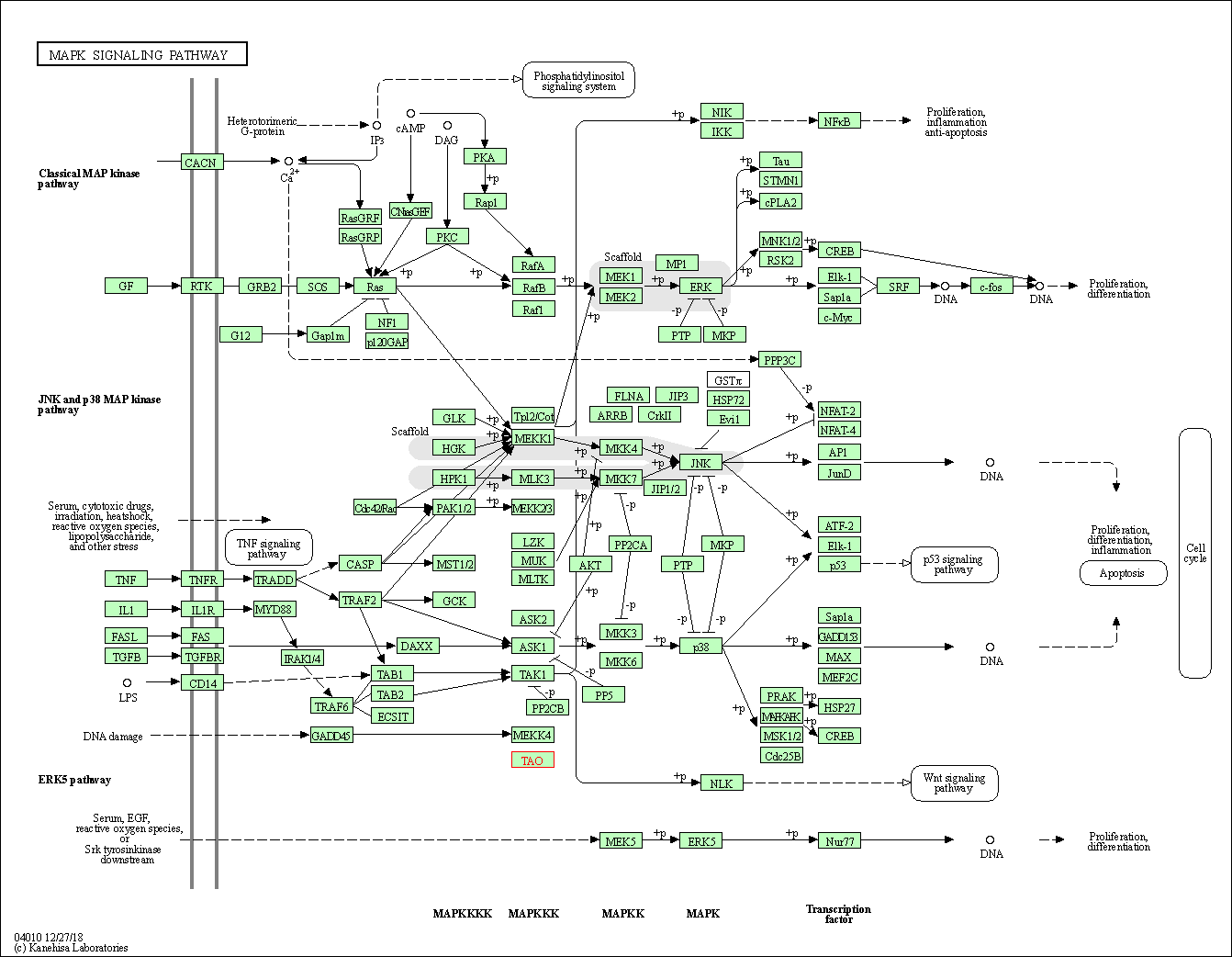Target Information
| Target General Information | Top | |||||
|---|---|---|---|---|---|---|
| Target ID |
T97016
(Former ID: TTDI03571)
|
|||||
| Target Name |
TAO kinase 1 (TAOK1)
|
|||||
| Synonyms |
hTAOK1; hKFC-B; Thousand and one amino acid protein kinase 1; TAOK1; Serine/threonine-protein kinase TAO1; Prostate-derived sterile 20-like kinase 2; Prostate-derived STE20-like kinase 2; PSK2; PSK-2; MARKK; MARK Kinase; MAP3K16; Kinase from chicken homolog B; KIAA1361
Click to Show/Hide
|
|||||
| Gene Name |
TAOK1
|
|||||
| Target Type |
Literature-reported target
|
[1] | ||||
| Function |
Serine/threonine-protein kinase involved in various processes such as p38/MAPK14 stress-activated MAPK cascade, DNA damage response and regulation of cytoskeleton stability. Phosphorylates MAP2K3, MAP2K6 and MARK2. Acts as an activator of the p38/MAPK14 stress-activated MAPK cascade by mediating phosphorylation and subsequent activation of the upstream MAP2K3 and MAP2K6 kinases. Involved in G-protein coupled receptor signaling to p38/MAPK14. In response to DNA damage, involved in the G2/M transition DNA damage checkpoint by activating the p38/MAPK14 stress-activated MAPK cascade, probably by mediating phosphorylation of MAP2K3 and MAP2K6. Acts as a regulator of cytoskeleton stability by phosphorylating 'Thr-208' of MARK2, leading to activate MARK2 kinase activity and subsequent phosphorylation and detachment of MAPT/TAU from microtubules. Also acts as a regulator of apoptosis: regulates apoptotic morphological changes, including cell contraction, membrane blebbing and apoptotic bodies formation via activation of the MAPK8/JNK cascade.
Click to Show/Hide
|
|||||
| UniProt ID | ||||||
| EC Number |
EC 2.7.11.1
|
|||||
| Sequence |
MPSTNRAGSLKDPEIAELFFKEDPEKLFTDLREIGHGSFGAVYFARDVRTNEVVAIKKMS
YSGKQSTEKWQDIIKEVKFLQRIKHPNSIEYKGCYLREHTAWLVMEYCLGSASDLLEVHK KPLQEVEIAAITHGALQGLAYLHSHTMIHRDIKAGNILLTEPGQVKLADFGSASMASPAN SFVGTPYWMAPEVILAMDEGQYDGKVDVWSLGITCIELAERKPPLFNMNAMSALYHIAQN ESPTLQSNEWSDYFRNFVDSCLQKIPQDRPTSEELLKHIFVLRERPETVLIDLIQRTKDA VRELDNLQYRKMKKLLFQEAHNGPAVEAQEEEEEQDHGVGRTGTVNSVGSNQSIPSMSIS ASSQSSSVNSLPDVSDDKSELDMMEGDHTVMSNSSVIHLKPEEENYREEGDPRTRASDPQ SPPQVSRHKSHYRNREHFATIRTASLVTRQMQEHEQDSELREQMSGYKRMRRQHQKQLMT LENKLKAEMDEHRLRLDKDLETQRNNFAAEMEKLIKKHQAAMEKEAKVMSNEEKKFQQHI QAQQKKELNSFLESQKREYKLRKEQLKEELNENQSTPKKEKQEWLSKQKENIQHFQAEEE ANLLRRQRQYLELECRRFKRRMLLGRHNLEQDLVREELNKRQTQKDLEHAMLLRQHESMQ ELEFRHLNTIQKMRCELIRLQHQTELTNQLEYNKRRERELRRKHVMEVRQQPKSLKSKEL QIKKQFQDTCKIQTRQYKALRNHLLETTPKSEHKAVLKRLKEEQTRKLAILAEQYDHSIN EMLSTQALRLDEAQEAECQVLKMQLQQELELLNAYQSKIKMQAEAQHDRELRELEQRVSL RRALLEQKIEEEMLALQNERTERIRSLLERQAREIEAFDSESMRLGFSNMVLSNLSPEAF SHSYPGASGWSHNPTGGPGPHWGHPMGGPPQAWGHPMQGGPQPWGHPSGPMQGVPRGSSM GVRNSPQALRRTASGGRTEQGMSRSTSVTSQISNGSHMSYT Click to Show/Hide
|
|||||
| 3D Structure | Click to Show 3D Structure of This Target | AlphaFold | ||||
| Cell-based Target Expression Variations | Top | |||||
|---|---|---|---|---|---|---|
| Cell-based Target Expression Variations | ||||||
| Different Human System Profiles of Target | Top |
|---|---|
|
Human Similarity Proteins
of target is determined by comparing the sequence similarity of all human proteins with the target based on BLAST. The similarity proteins for a target are defined as the proteins with E-value < 0.005 and outside the protein families of the target.
A target that has fewer human similarity proteins outside its family is commonly regarded to possess a greater capacity to avoid undesired interactions and thus increase the possibility of finding successful drugs
(Brief Bioinform, 21: 649-662, 2020).
Human Tissue Distribution
of target is determined from a proteomics study that quantified more than 12,000 genes across 32 normal human tissues. Tissue Specificity (TS) score was used to define the enrichment of target across tissues.
The distribution of targets among different tissues or organs need to be taken into consideration when assessing the target druggability, as it is generally accepted that the wider the target distribution, the greater the concern over potential adverse effects
(Nat Rev Drug Discov, 20: 64-81, 2021).
Human Pathway Affiliation
of target is determined by the life-essential pathways provided on KEGG database. The target-affiliated pathways were defined based on the following two criteria (a) the pathways of the studied target should be life-essential for both healthy individuals and patients, and (b) the studied target should occupy an upstream position in the pathways and therefore had the ability to regulate biological function.
Targets involved in a fewer pathways have greater likelihood to be successfully developed, while those associated with more human pathways increase the chance of undesirable interferences with other human processes
(Pharmacol Rev, 58: 259-279, 2006).
Human Similarity Proteins
Human Tissue Distribution
Human Pathway Affiliation
|
|
|
Note:
If a protein has TS (tissue specficity) scores at least in one tissue >= 2.5, this protein is called tissue-enriched (including tissue-enriched-but-not-specific and tissue-specific). In the plots, the vertical lines are at thresholds 2.5 and 4.
|
| KEGG Pathway | Pathway ID | Affiliated Target | Pathway Map |
|---|---|---|---|
| MAPK signaling pathway | hsa04010 | Affiliated Target |

|
| Class: Environmental Information Processing => Signal transduction | Pathway Hierarchy | ||
| Chemical Structure based Activity Landscape of Target | Top |
|---|---|
| References | Top | |||||
|---|---|---|---|---|---|---|
| REF 1 | Cdc7 kinase inhibitors: 5-heteroaryl-3-carboxamido-2-aryl pyrroles as potential antitumor agents. 1. Lead finding. J Med Chem. 2010 Oct 28;53(20):7296-315. | |||||
If You Find Any Error in Data or Bug in Web Service, Please Kindly Report It to Dr. Zhou and Dr. Zhang.

